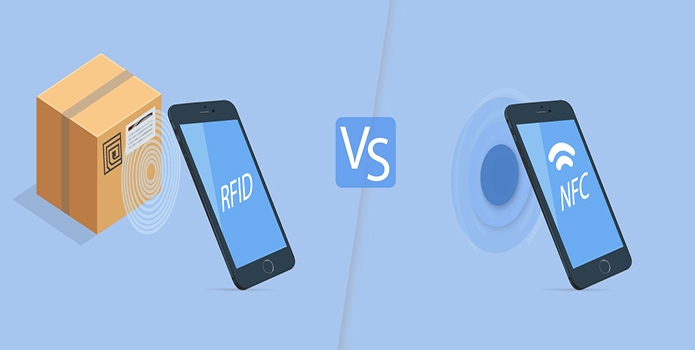The primary difference between RFID and NFC is that NFC works only with short distances (usually less than 10 cm), and it can be powered by capacitive energy transfer.
On the other hand, RFID uses the frequency of 125 kHz/13.56 MHz and requires a power source (battery or induction coil). It offers a maximum range of 100 meters.
Besides these differences, the technologies are pretty similar. This article gives an in-depth comparison between NFC and RFID.
¿Qué es RFID?
RFID (Radio Frequency Identification) is a wireless non-contact technology that uses electromagnetic fields to transfer data from the Tag (transponder) to the Reader (interrogator).
The two main components of an RFID system are a tag and a reader device, each having an antenna. The transmission medium is the air interface.
It works at very high frequencies (125 kHz/13.56 MHz). As such, it allows large amounts of data to be transferred quickly between two transponders or between a transponder and a reader.
What are the Applications of RFID?
Hay muchos usos de RFID. Se puede utilizar para coordinar y controlar el acceso en diferentes sectores, como plantas industriales o fábricas. Como tales, estas etiquetas pueden mejorar la productividad de los procesos industriales y reducir los desechos al monitorear el uso de materias primas y productos terminados.
También es útil para administrar y monitorear activos, como camiones comerciales o contenedores en puertos o aeropuertos. De esta forma, evita pérdidas por robo o mal manejo.
Por ejemplo, si una empresa tiene varios almacenes, puede localizar su mercancía allá donde vaya simplemente instalando un lector RFID en la entrada de cada almacén.
La tecnología RFID también se puede utilizar en muchas otras áreas, tales como:
- Identificación y control de acceso
- Seguimiento de vehículos
- Seguimiento de animales/mascotas,
- Sistemas de pago (integración con tarjetas de crédito) y telefonía móvil
¿Qué es NFC?
NFC (Near field communication) is a wireless communication technology that allows two electronic devices closely placed (up to 4 cm) to establish communication and exchange data.
It is related to RFID but it works at lower frequencies (13.56 MHz). They allow large amounts of data to be transferred quickly between two transponders almost simultaneously.
NFC is comparable to Bluetooth, Infrared (IR), and Wireless LAN standards. Although each of these technologies has its protocol standard, they all establish communication using electromagnetic fields.
This technology requires short-range, so it is used to create wireless connections between small portable devices such as mobile phones or tablets.
What are NFC Tags?
An NFC tag contains information that different applications can access – usually through an NFC Service ID assigned by the manufacturer, depending on what service this tag will offer.
They have an NFC chip and an antenna embedded in a label or printed directly on a surface. The tag can be read from up to 20 cm (7.9 in) away by an active NFC device such as modern smartphones.
What are the Applications of NFC?
NFC tiene varias aplicaciones, incluida la transferencia de archivos entre teléfonos inteligentes, sistemas de pago, emisión de boletos de transporte público y tarjetas de control de acceso de contacto.
Además, los lectores NFC se pueden fijar en lugares específicos para una transferencia de datos rápida. Un ejemplo de esto son los cajeros automáticos, donde debe tocar su tarjeta de crédito en un lector para que pueda leer información útil, como el número de cuenta, la fecha de vencimiento y el código de seguridad.
De esta manera, realizar una compra en línea es seguro ya que nadie podrá robar su contraseña o cuenta bancaria durante el pago, a menos que tengan acceso a ese dispositivo NFC (ATM) que almacena sus datos bancarios.
Otro solicitud de etiquetas NFC está en la publicidad. Muchas empresas quieren que su mensaje salga a la luz, pero no todas tienen suficiente dinero para comprar anuncios de televisión. Estas empresas crean artículos especiales que contienen el logotipo de la empresa con una etiqueta NFC incrustada en su interior, de modo que cuando alguien pase cerca con un móvil habilitado para NFC, la etiqueta se escaneará y aparecerá un mensaje.
Etiquetas NFC también se puede utilizar para iniciar aplicaciones o acciones específicas en su dispositivo. Es posible que haya visto esto en acción en lugares públicos donde se le pide que no use su teléfono sino que lo toque contra un lector.
Un ejemplo de esto es Google Wallet, donde puede realizar compras en línea tocando su teléfono móvil contra un lector NFC. Esta acción inicia Google Wallet para transferir los datos necesarios para completar la transacción.
RFID vs. NFC – What is The Difference?
These technologies work on the same principle: sending and receiving data without any physical contact. While their speeds are very close, RFID is faster for a wide read range while NFC works in a smaller area.
Both RFID and NFC do not require a direct line of sight. As such, you can read the tags from whichever angle you find convenient. This feature makes the tag more reliable and faster compared to barcodes.
However, there are a few differences between RFID and NFC, including:
- Frequency of Operation. NFC operates only at 13.56 MHz while RFID can operate within a frequency range of 134.2 kHz to over 900 MHz.
- Rango de lectura. NFC operates optimally when the reader and the tags are a maximum of 10 cm away from each other. This short read range limits NFC to data exchange, contactless payments, and proximity cards. On the other hand, RFID tags can have a read range of up to 100 meters, thus making them ideal for tracking.
- Memory. RFID tags have a larger memory capacity than NFC. The feature makes them useful where you need to store massive amounts of data. Most RFID tags are not writable so it will be hard to change the data on there without erasing everything and writing it again. However, you can get one with write/read abilities.
- Functionality. RFID deals particularly with identification while NFC deals with communication. RFID is ideal for processing large amounts of data within a short time.
Both NFC and RFID are highly reliable. However, you should define your needs before you settle for one. If you need one for identification and access control, then we recommend RFID. If you need one for communication and data exchange, then you should choose NFC.
Artículos relacionados
- Cómo programar etiquetas NFC
- ¿Qué es el pago NFC?
- Teléfonos con NFC en 2021: lista de dispositivos móviles habilitados para NFC
- Cómo usar NFC en iPhone: ¡esto es lo que necesita saber!
- Los 12 mejores usos de las etiquetas NFC que harán que tu vida sea divertida
- NFC vs. RFID: ¿Cuál es la diferencia entre ellos?
- Aprenda todo sobre los diferentes tipos de etiquetas RFID
- Una guía para principiantes: ¿Qué es una etiqueta NFC?


